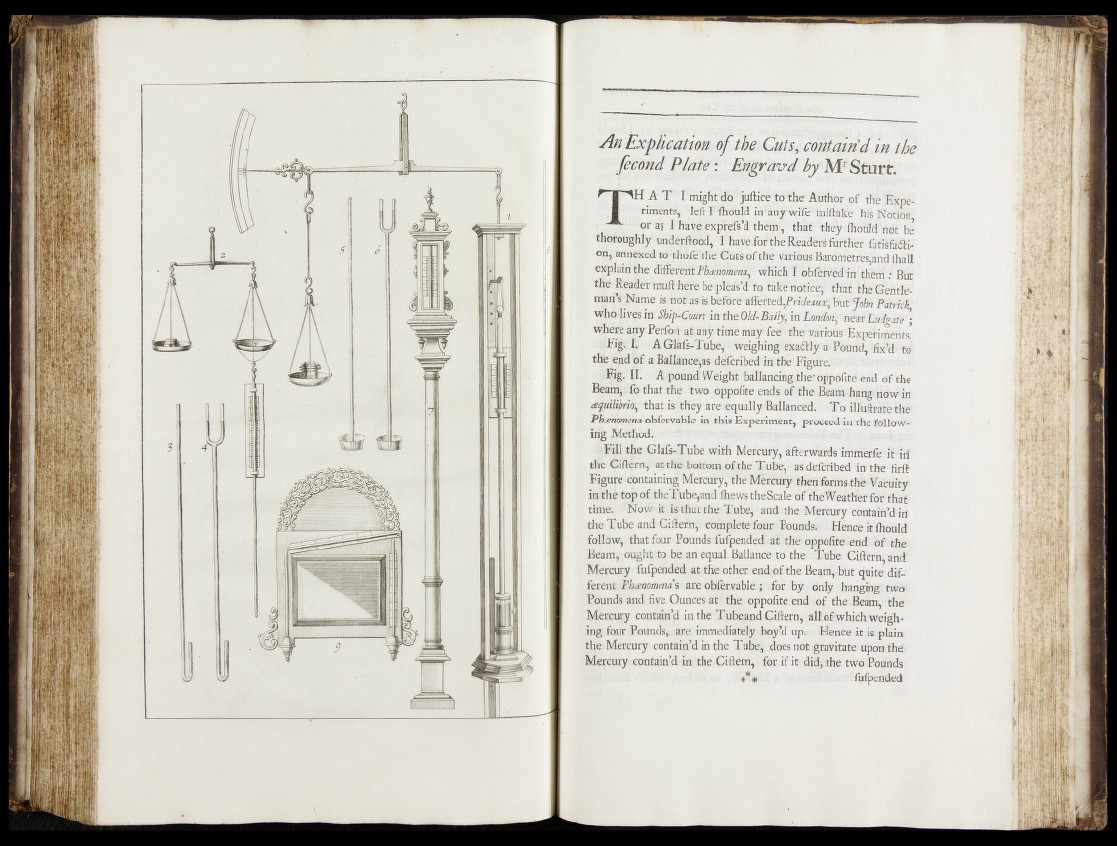
An Explication of the Cutf contain'din the
fécond Platt: Engrawd by M r S t u r t .
TH A T I might do jiifticë; td the Author of tfiéJÉxpe-
rimérits, "left I fliould his Notibfi
1 1M Qr a? 1'ha^é ekf<reis’d them| thk ^they - fliodM'ndt Be
thoroughly undèrftood, I havé fo^théRfeaderé furthér fafiifkóti-
on, annexed tofthófe'the Cuts1 of the Various Bafdmétres,ind (hall
explain the different Pbdhokena^ ‘ which I obférved in therà ; But
the Reader muft here be-pleas’d to tfhkfé noticé& -that theGentlé-
mans Name is-hbt as-is before' afTeked^P^J^^bü't'yóöA Patrick
who lives in Sbip-Coart in the Old-Bailjÿiû London^ nekr Lùd^Mé §
where any Perfon ai>any time mayTèe- the' varioüsTxpêWerits*
I’ t A Glàfs-Tube,‘ | weighing éxaétly a Pound, W d to
the end of a Ballance,as ddfcribed inth9pigure-.n^
llig. II. A pound Weight balancing the^oppofit© end of thé
Beam, fo that the two oppofite Onds of the Beam-harfg ffow iff
oefuiÉriàii that is; they are -equally Ballanced. To illuftra'te theif
Phenomena obfervable in this Experiment, proceed in thé follÔ#à*
ing Method.
5 T il t|e Glafs-Tube with Mercuty^ afterwards imÖifefF^ii id"
the Ciftern, at the bottom of the Tube, asdefcribed in the fifft
Figure containing Mercury, the Mercury then forms the Vacuity
iff thé top of theTube,and (hews
time. Now it is that the Tube, and the Méfcury cöntainM'irt
the Tube and Ciftern, complete four Pounds.- | Hende it fhould
follow, that four Pounds fufpended: at the oppofite end- Of the
Beam, ought to be an equal Ballance to the -Tube Ciftern, and
Mercury fufpended at the other end,of the Beam, but quite different
Phenomena’s are obfervable ; for by Only hanging two-
Pounds and five Ounces at the oppofite end of the Beam, the
Mercury contain’d in the Tube and Ciftern, ail Oftwhich weighing
four Pounds, ate immediately boy’d up& ? Hence it is plain
the Mercury contain’d in the Tube, does not grWitate upon thé
Mercury contain’d in the Ciftern, for if its did, the two Pounds
**# fufpended